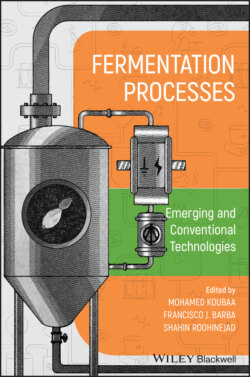Читать книгу Fermentation Processes: Emerging and Conventional Technologies - Группа авторов - Страница 17
1.2.1 Energy Transfer and Redox Reactions
ОглавлениеThe energy released by the catabolic reactions is associated with the electrons of molecules that are degraded during these reactions. This energy is transferred to a molecule of ADP to form ATP. More specifically, a phosphate group is added to the ADP molecule, with an energy investment, to form an ATP molecule (Figure 1.1). The energy contained in organic molecules cannot be released all at once; otherwise, it would be practically all lost in the form of heat, as during combustion. It must, therefore, be gradually transferred to the ATP molecules via the cascades of redox reactions.
First, the energetic nutrients are oxidized, which allow them to behave as electron donors (e−). During this reaction, two electrons and two protons (H+) are transferred to a coenzyme known as nicotinamide adenine dinucleotide (NAD+) to be reduced in the form of NADH + H+. A part of the chemical energy contained in nutrients is then transferred to the NAD+ by the electrons, according to the reduction reaction in Eq. (1.1).
(1.1)
Overall, each time an organic molecule is oxidized (the loss of electrons and H+ ions), there is simultaneously a reduction of NAD+ taking place. This is why we talk about “redox reactions.” The newly formed NADH will then undergo oxidation, in turn, to release stored energy (Eq. (1.2)), which will eventually be transferred to ATP molecules by various chemical processes.
(1.2)
At the end of the energy transfer process, the released electrons and protons (H+) must be picked up by a final acceptor. This acceptor will vary according to the preferred catabolic pathway: aerobic respiration, anaerobic respiration, or fermentation.
